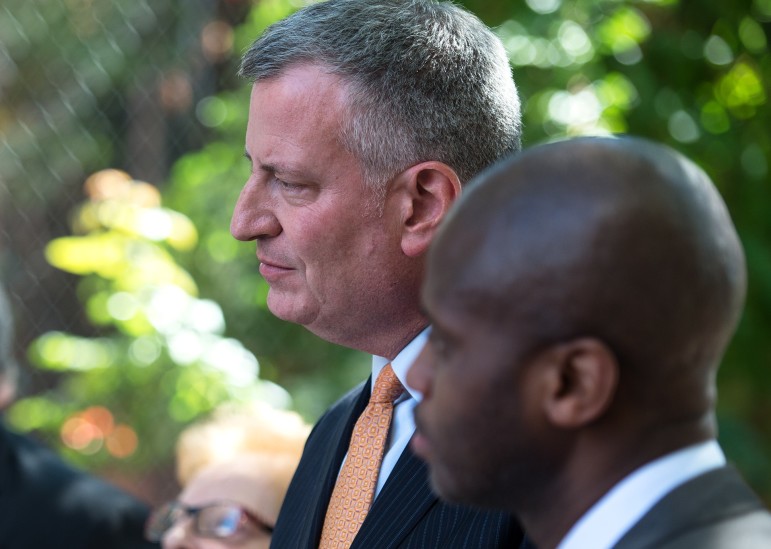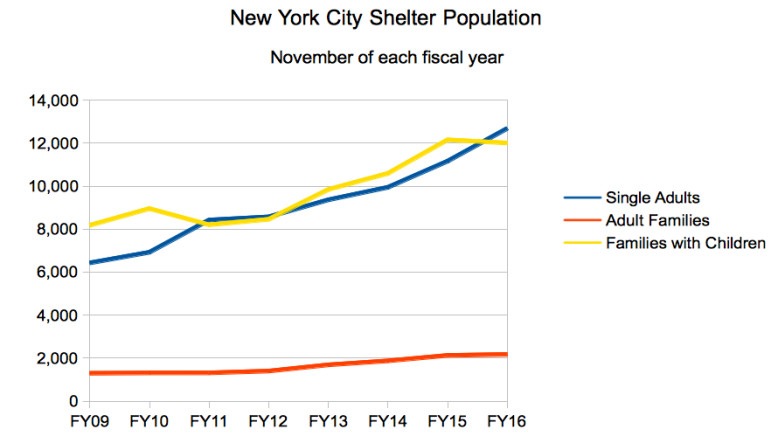
Demetrius Freeman/Mayoral Photography Office
The mayor with outgoing DHS head Gilbert Taylor at an event in September.
Mayor de Blasio on Tuesday announced a shakeup of his administration’s approach to homelessness, with the departure of Department of Homeless Services (DHS) Commissioner Gilbert Taylor and the launch of a 90-day review of how homeless policy is delivered. The review, overseen by Human Resources Administration (HRA) Commissioner Steve Banks, will focus on the ways HRA, which manages the city’s social safety net, works with DHS when it comes to the city’s near-record homeless population.
De Blasio stepped into a homelessness crisis when he took office, and the numbers have only grown worse since. A major factor in that growth is an increase in the number of people entering shelters: The tally of single adults entering the system has jumped nearly 10 percent in the past two years, and the number of families with children coming in has also risen.
Although he has been criticized for the rising shelter numbers and took big hits this summer over the increasingly visible street homeless population, de Blasio has taken several steps to try to address the issue. He’s launched eight new rental subsidy programs, restored the set-aside of a small number of NYCHA apartments for shelter leavers and boosted spending for homeless prevention programs. He recently announced a create 15,000 units of supportive housing.
There are no shortage of ideas on what else to do. The Institute for Children, Poverty, and Homelessness is out with a report on Wednesday that reviews previous city policies and concludes “past attempts that focus only on housing to address family homelessness have led to rising shelter numbers and increasing costs.”
“With no sign that the current crisis will decline on its own, it is time to recognize that family homelessness is more than just a housing issue; a one size policy does not fit all when it comes to solving the homelessness crisis the city is facing. Homelessness is a multi-faceted issue that requires a multifaceted solution, one with services targeted to families’ specific needs.” As it has in the past, ICPH recommends adopting a three-level shelter system where families facing just a short-term crisis are given one form of help, while those with deeper problems receive different services.
Some homeless policy advocates are skeptical of switching to such an approach given the nature of the homeless population today. As de Blasio said Tuesday:
This challenge of homelessness is one that asserted itself deeply during the Koch administration, and I know that administration worked very hard to address what was then a new and unprecedented problem. It has persisted through the Dinkins administration, the Giuliani administration, the Bloomberg administration, and now into ours. But what we have seen in recent years is a new face of homelessness, a new set of challenges. More and more of our homeless are family members and not single adults. More and more of our homeless are homeless for economic reasons – not because of substance abuse or mental health problems, but because they are having trouble making ends meet to such a point that they literally can’t afford a place to live anymore, given the cost of housing in this city and given that there are still so many low-wage and low-benefit jobs. So we have to go at this challenge holistically. It’s very much connected to the bigger challenge of income inequality that we’re taking on every day.









